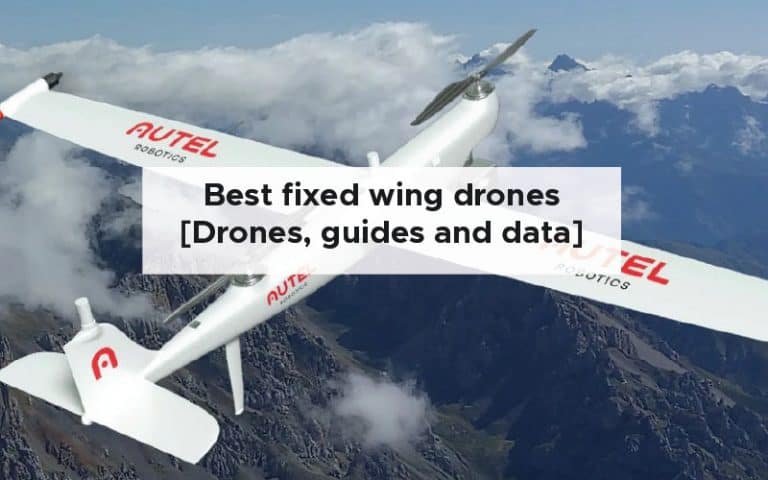There are many applications for a fixed wing drone where a four propeller drone simply cannot compete. The best fixed wing drones have long flight times, high carrying capability, vertical takeoff capabilities, and are able to take photos and thermal imaging at the same time over a huge area. In this article, I’m in a share with you the best fixed wing drones on the market and give you a detailed understanding of what is important when you are deciding to purchase one.
The best fixed wing drones on the market include the Vertical technologies DeltaQuad Pro, Wingtra and Autel Dragonfish. The best drone for you will depend on what flight time and camera you need for your specific application.
When people think of a drone they typically imagine a quadcopter. That is, 4 propellers attached to 4 arms on a drone that can hover and move freely in 3D space.
A fixed wing drone relies on forward momentum to create lift which increases the amount of energy which is required to stay in the air and greatly extending the flight time by reducing battery drain.
Here is a complete rundown on what fixed wing drones are and the advantages and disadvantages compared to quadcopters.
What are fixed wing drones?
Broadly speaking, an unmanned aerial vehicle is an aircraft without a human pilot, crew or passengers on board. They are also commonly known as drones. The term drone can mean that the physical structure of the craft can take a variety of forms.
One of these forms is a fixed wing drone.
The fixed wing drone looks very much like an aeroplane. There are a number of different designs and wing shapes which impact the flying capabilities of the drone. There are three types of wings:
- Delta wing
- Swept wing
- straight wing
These wings are rigid and are shaped like an aeroplane’s wing which provides lift as the drone is flying forward. The lift provided by the shape of the wings (creating a low-pressure region above the wing during forward flight) means that the propeller only has to provide forward momentum. However, some fixed wing drones are now able to do vertical takeoff and landing is due to ability to change the propeller directions.
Typically, these fixed wing drones are used in aerial mapping, surveillance and surveying due to their extended flight times and range.
There are a range of advantages and disadvantages of fixed wing drones compared to other types of drones on the market and we shall look at those, now.
Advantages of fixed wing drones
Not every application of drones is best suited to quadcopter drones. One of the major drawbacks of using a quadcopter drone is the incredibly limited battery life. In the past few years the battery life of drones has increased dramatically thanks to the technological advancement of novel battery types such as the lithium polymer battery. However, the maximum flight time of the typical four propeller drone is approximately 30 to 40 minutes. Many people find that there drone lasts much less time than the manufacturer reports.
In the instances where the limitations of quadcopters stop drones from being useful fixed wing drones could potentially help.
MUCH longer flight time
Fixed wing drones have a significantly longer flight time than quadcopter drones. This is because the wing shape of the drone provides lift much like an aircraft wing.
The flight time of a fixed wing drone can exceed two hours depending on the direction of the wind and if it is carrying any payloads.
To see how much better the fixed wing drone flight time is compared to a quadcopter check out some of the models in the table, below.
| DJI Mavic air 2 | 34 |
| DJI Mavic air | 17 |
| DJI Mavic mini 2 | 31 |
| Autel EVO 2 | 40 |
| Parrot Anafi | 25 |
| Autel Dragon fish * | 120 |
| Parrot disco * | 45 |
| Delta Quad Pro* | 120 |
You can see from the above table that it is common for professional fixed wing drones to have a flight time of up to 2 hours – 120 minutes.
Vertical take off
in the past, fixed wing drones required a takeoff and landing spot to be operated efficiently and safely. They evolved the ability to be launched from a short platform to overcome the requirement of a long runway but the issue of requiring forward momentum limited their ability to be taken up for a variety of uses.
In recent years, thanks to the advances of small electronics and electrical components, the fixed wing drones have been able to take off vertically in a manner much like quadcopters. This has enabled them to get over one of the big hurdles for mass adoption.
You can see the vertical takeoff and landing drone, Wingtra, below.
this new generation of fixed wing drones allows for vertical landings and takeoffs everywhere even in confined spaces and on rocky and uneven grounds. This, in combination with the efficiency of forward flight you now can accomplish large surveying flight missions anywhere.
Glide to safety
One of the trickiest issues to overcome with a quadcopter drone is that as soon as the propeller becomes damaged or a motor fails the drone will immediately fall out of the sky. There have been a series of experiments of drones flying with less than four propellers which you can read about in my other article – can a drone fly with three propellers? [Videos of experiments] – click here to be taken to article.
The great thing about a fixed wing drone is that should the propellers fail the drone will simply glide to safety.
You will not be able to do a vertical landing but you will be able to guide the drone to an area for a soft landing.
This added level of safety makes the pilot much more relaxed throughout the flight and gives them the opportunity to completely recover their drone should the motor fail.
Stability in high winds
Lastly, one of the benefits of this sort of drone is its high stability in strong winds. Because of the forward momentum created by the propellers and the continuous movement through the air, the drone is much more stable which makes it much more suitable for high-resolution mapping where the camera footage needs to be as smooth as possible.
This is what makes fixed wing drones the go to option for surveying and mapping purposes.
Here are some of the disadvantages of working with fixed wing drones.
Disadvantages of fixed wing drones
Even though there are plenty of advantages to using fixed wing drones there are some drawbacks that, only recently, have been overcome using new technology.
Unable to remain stationary
A fixed wing drone is not designed for hovering.
The forward momentum provided by the propellers combined with the lift provided by the wings means that the drone must always be moving in a forward direction to maintain lift.
If the drone was to stop in midair it would simply fall out of the sky. However, if there is plenty of distance between the stall height and the ground the drone will simply glide to safety, as we’ve talked about above.
If your application for a drone requires that the drone inspects something in detail a fixed wing drone would not be your best option. The best application for a fixed wing drone is where the drone will be covering large distances and/or carrying payloads. Both of these are very energy intensive and the lift provided by the wing shape reduces the drain on the battery.
Not good for low level flight
Because a fixed wing drone needs to be in constant forward momentum it can be much harder to navigate around at low levels. Very high competency is required to make sure that the drone just doesn’t simply crash into the nearest tree.
Fixed wing drones are much better for high altitude surveying and mapping since they can move forward at a constant speed and be less affected by the winds and weather conditions.
Not foldable
Fixed wing drones are less portable than quadcopter drones since the wings are, generally, not as foldable as the arms on a four propeller drone.
One of the great things about quadcopters is that they are able to be packed down into a relatively small form factor for transport between flights. The DJI Mavic air is one of my favourite drones due to its size and feature set. It packs down to an incredibly compact package which means that I am able to carry it daily without any issues.
A fixed wing drone will require a bigger case or backpack for transport to take off locations.
Some manufacturers have dedicated pelican or carry cases but for others, you will have to create your own.
Expensive
The last issue with fixed wing drones are that they can be relatively expensive. Compared to a quadcopter drone, which are able to be found at budget prices, fixed wing drones – at least the good ones – will set you back many hundreds if not thousands of dollars.
You can purchase some relatively inexpensive fixed wing drones but these tend to be more toys than tools.
Now that you understand exactly what a fixed wing drone is and its advantages and limitations here are the best fixed wing drones that are currently available on the market.
Best fixed wing drones
The best fixed wing drone for your specific use case will depend very much on what you need the drone to do. In this list I have tried to cover some of the most feature packed drones as well as some of the fixed wing drones which are accessible to the everyday drone hobbyist.
Vertical technologies DeltaQuad Pro
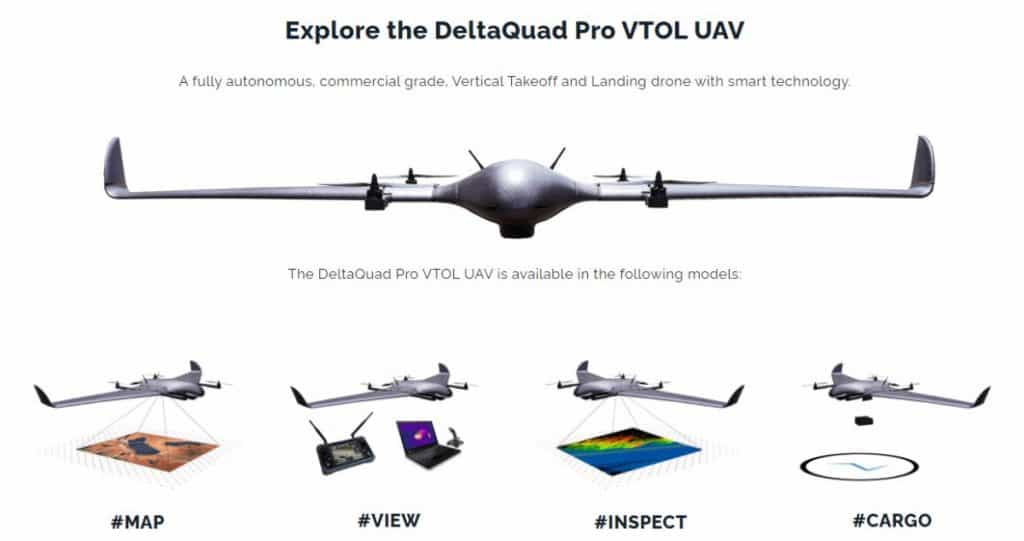
This drone is a fully autonomous commercial grade vertical takeoff and landing drone with a load of smart technology included. It comes in a variety of models that includes:
- MAP – providing up to 2 hours of flight time and a coverage of 1200 hectors it is used for mapping and surveying purposes with a 61 megapixel camera.
- VIEW – this mode is perfect for surveillance and reconnaissance purposes with a live HD video stream for up to 50 km with autonomous object following with thermal and colour cameras.
- INSPECT – this is for powerline, pipeline, and other thermal inspections.
- CARGO – this fixed wing drone has a full payload delivery system of up to 12 kg with a dropping mechanism and a live first person view video perfect for transportation and delivery.
Irrespective of the model that you choose this drone has a vertical takeoff and landing capability which means it can take off in the trickiest of environments.
It has a 150 km flight distance or up to a 100 km if it is carrying a 1.2 kg payload. It is fully autonomous which means missions can be controlled beyond communication range with the controller.
It can be put together in under one minute in the field which means that you can get flying as soon as possible – and it can even fly in the rain and snow due to the integration of smart technology.
Being manufactured in the Netherlands means that you do not have to rely on Chinese security or data laws while flying this drone.
Wingtra
Wingtra is a fixed wing drone which allows you to fly at up to 36 mph for up to 39 minutes per flight – this means that a huge area can be monitored.
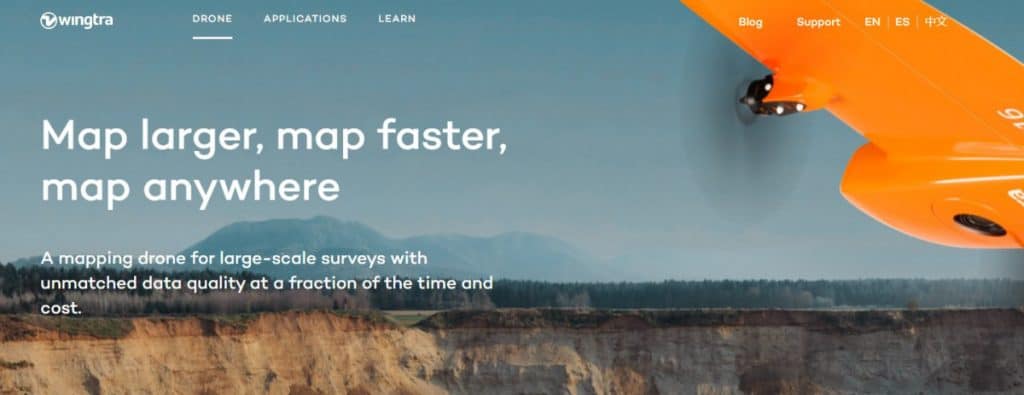
It has a 42 megapixel camera which means that you can fly higher than some other drone cameras which means that you can capture more detail with every picture and cover a much larger area. The maximum coverage is up to hundred and 10 ha or 272 acres at an altitude of 93 m.
The fact that you are able to capture a lot more data much quicker means that the cost of capturing data is significantly reduced.
The drone is able to take off and land vertically which means that it can land as easily and efficiently as a multi-rotor drone. Some fixed wing drones need to be launched like a plane there is this one takes off vertically and then is able to fly away after a vertical takeoff. This means that you can collect data where other fixed wing drones cannot.
The drone is able to carry a wide range of different cameras all the way from a simple camera up to a thermal camera with high resolution narrowband is for advanced thermal, multispectral, and high resolution imagery in one single flight.
If you want to map large areas of your agricultural activities this is a drone that you should absolutely consider.
Autel Dragonfish
This drone is produced by Autel which is well known for its EVO 2 series quadcopters.

It is a super long endurance drone that has the ability for a 4K with 20 times stabilised optical zoom.
It has a unique tilt rotor design which simplifies the operation and maximises the efficiency of the flight stop it is modular, waterproof, smart and reliable and is able to fly for up to 120 minutes including a payload. It has a level VI wind resistance which means that is able to fly in wind speeds of up to 17.7 mph.
Just like others in this list, it is able to do vertical takeoff and landing so that you can take off in the tightest of spots. With a three minute quick assembly and a five-second system boot and self check your be flying in no time.
It is able to tackle a variety of missions using one button landing and takeoff, high-speed tracking using artificial intelligence, and it provides adaptive tracking, point of interest flights and advanced mission planning.
The body is completely modular and you are able to take off the wings and all of the components for easy packing. You just have to make sure your bag is as big as one of the wings.
Parrot Disco
This drone is a perfect drone for those who want to try a fixed wing drone without spending many thousands of dollars. You can buy it for approximately US$650.
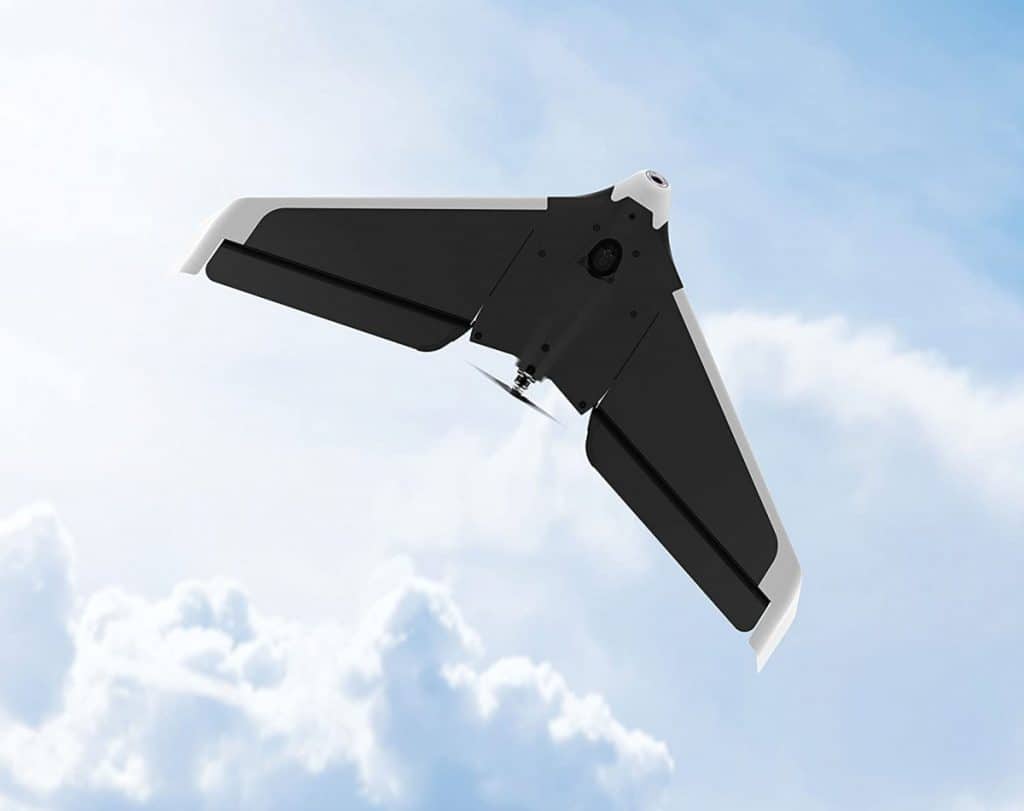
This fixed wing drone is able to reach speeds of up to 50 mph and comes with a set of goggles which will show you the first person view while flying. It is able to shoot in full HD 1080p with 14 megapixels photo. The camera is in a fixed position but has a wide angle lens. The footage can be captured in raw, JPEG, and TNG formats.
The controller which comes with the drone has two joysticks for ultraprecise piloting and can fly the drone up to 1.2 miles away. It has a return to home feature like many Quadcopter drones.
It has a 45 minute battery life and has automatic takeoff and landing so that you can get flying as soon as you receive the package.
Marlyn
This fixed wing drone can fly in winds of up to 45 km/h. Which is 28 mph. It is able to take off from any 2 x 2 metre area like a quadcopter like many of the vertical takeoff and landing drones in this list.
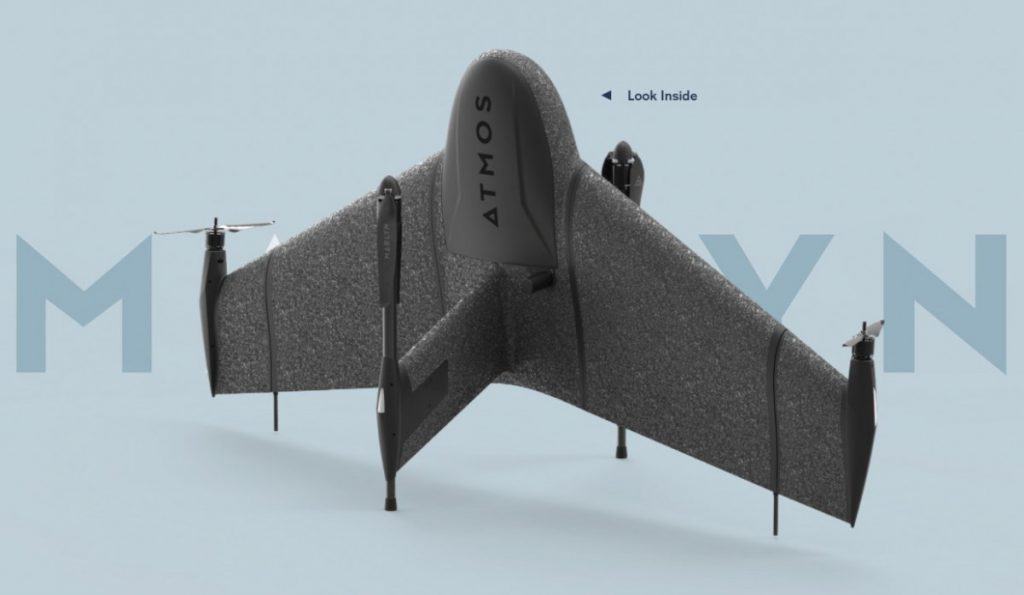
It is manufactured in Europe to the highest quality and ethical trade standards. The setup time takes as little as five minutes and it has a range of autonomous flight features.
It has a single button takeoff on landing and is able to cruise at a top speed of 60 mph. The maximum flight time is approximately 50 minutes and can carry approximately 1 kg of payload.
Sonicmodell AR Wing Pro – Build it yourself
If you want to build your own drone this is a fantastic kit which enables you to build a fixed wing drone. This drone cost approximately $105.
You buy this drone as a kit which includes all of the hardware including and uninstalled motor, ESC, motors, propeller, and all the hardware you need.
It is the world’s first first person view fixed wing drone with a dedicated nose camera Bay. It also has a main hatch Bay for any DJI hi definition air unit system. The front no slot is compatible with all action cameras in the market including DJI and GoPro.
It has detachable main wings and wingtip which means that you can take apart the drone for transport.
This drone can fly at a maximum speed of 130 km/h or a cruising speed of approximately 80 km/h.
Here is a YouTube video from someone who help design this drone:
sense Fly eBee X
This drone is lightweight and is able to be hand launched. It clicks important aerial mapping data safely and efficiently with a suite of purpose-built mapping cameras.
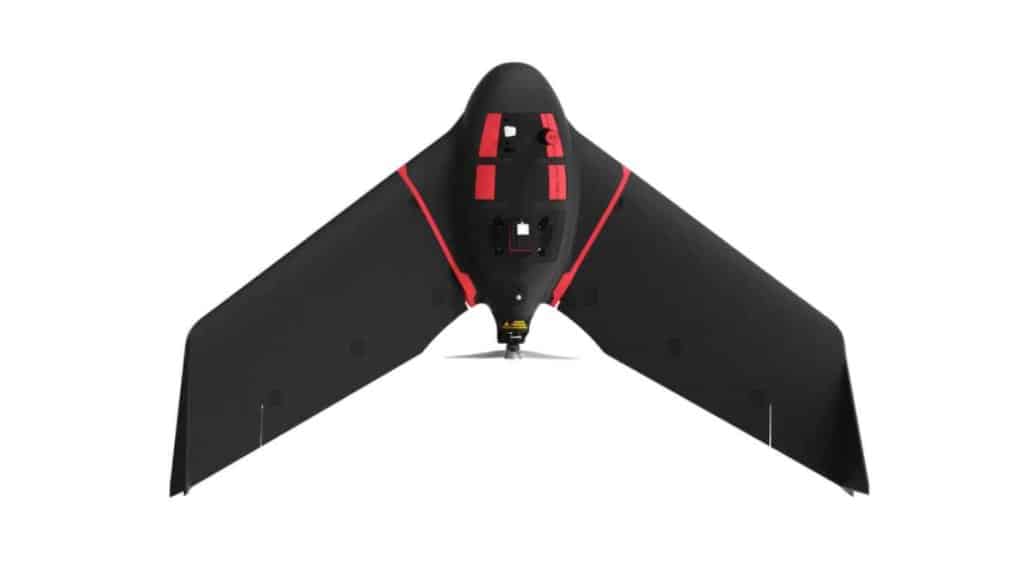
It has a maximum flight time of approximately 90 minutes and has a maximum coverage of up to 500 ha or 1235 acres at 400 foot. You are able to achieve an absolute accuracy of down to 3 cm using the RTK modules.
It has a huge range of output capability including 3D point cloud, digital surface modelling, 3D mesh with textures, undistorted image capturing, and Google maps out.
The drone has a wingspan of 116 cm and a very low noise motor system. It only weighs approximately 1.3 to 1.6 kg depending on the type of camera it is carrying and the battery size you have decided to take off with. It is able to fit in a backpack which comes with the drone. This makes it perfect for carrying to and from your takeoff location.
Fixed wing drone buyers guide
The perfect drone for someone will certainly not be the best drone for someone else with a different use case in mind. In this section, we are going to have a look at the best advice for choosing a fixed wing drone so that you can buy with confidence and avoid buyers remorse.
Size
The size of the drone is very important. Fixed wing drones are typically less portable than quadcopter drones. Typically, a fixed wing drone is only able to collapse to the size of the wing.
Some drones are able to be taken apart by disconnecting the wings on either side of the drone body. Other drones are not able to be taken apart at all.
The size also dictates its stability in strong winds. A much larger drone will be able to withstand higher wind speeds than smaller fixed wing drones. You have to balance the size with portability and the conditions that you are flying in.
Flight time
Fixed wing drones have a much bigger flight time due to the fact that they use aerodynamics similarly to a plane. A typical drone will be able to fly anywhere between 50 minutes and up to 120 minutes.
Here are some common flight times of fixed wing drones:
| DELTAQUAD PRO | 110 minutes |
| WINGTRAONE | 60 minutes |
| TRINITY F90+ | 90 minutes |
| MARLYN | 50 minutes |
| EBEE X | 60 minutes |
You can see that these are much higher than the 30 minute typical flight time of quadcopters. Essentially, the longer the flight time the more area the fixed wing drone is able to cover which means that you can survey a much larger area.
Camera options
Choose a drone with the camera which you require – such as a thermal camera or a optical camera – or purchase a fixed wing drone which has the capacity to change cameras.
Most fixed wing drone manufacturers want to lock you into their camera system by making the camera completely encased in the body.
Others, allow you to swap out the different cameras within the ecosystem and very few actually allow you to swap in and out a range of different cameras.
That means that when you are selecting your drone you need to make sure that you have the ability service any fringe situations with the type of camera that comes with that drone.
Vertical take off
Vertical takeoff and landing (VTOL) is becoming an increasingly common feature in fixed wing drones. This is because it offers a much greater flexibility of takeoff locations and allows the pilot to take off in the most confined spaces.
If you opt for a drone that hasn’t got vertical takeoff and landing capabilities you will have to make sure that the area you are flying has the capacity for a hand launch – where you chuck the drone forward – or a runway which is a few hundred metres long.
Cargo capacity
Lastly, fixed wing drones are very useful for cargo carrying. The lift provided by the forward momentum means that it is less training on the battery and the cargo can be carried much further.
If you are buying a fixed wing drone to carry items, make sure that the battery has the capacity with the increased load.
Summary
In this article, we have gone over the best fixed wing drones currently available on the market and exactly what you need to look for in your purchase.
These drones tend to be a lot more expensive than quadcopter drones which means that you need to make sure you are making the right decision for you.
